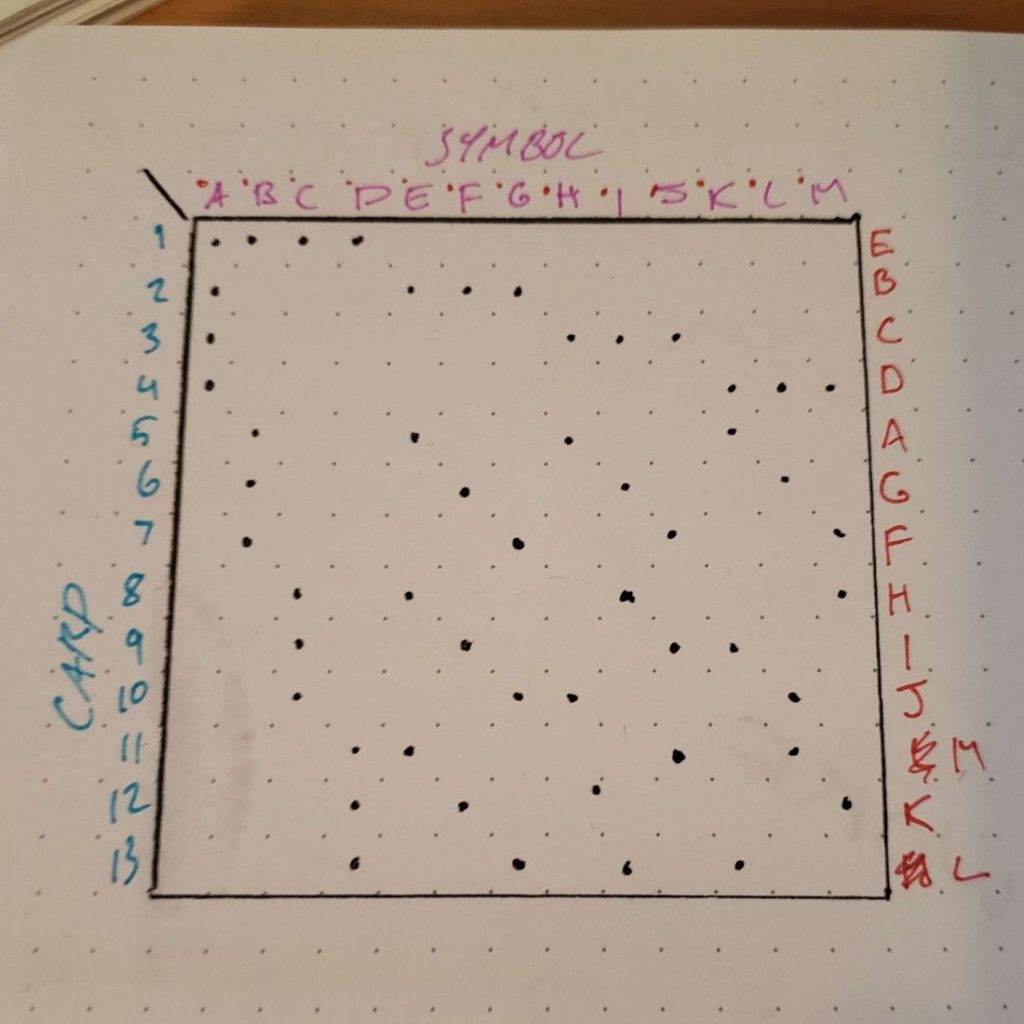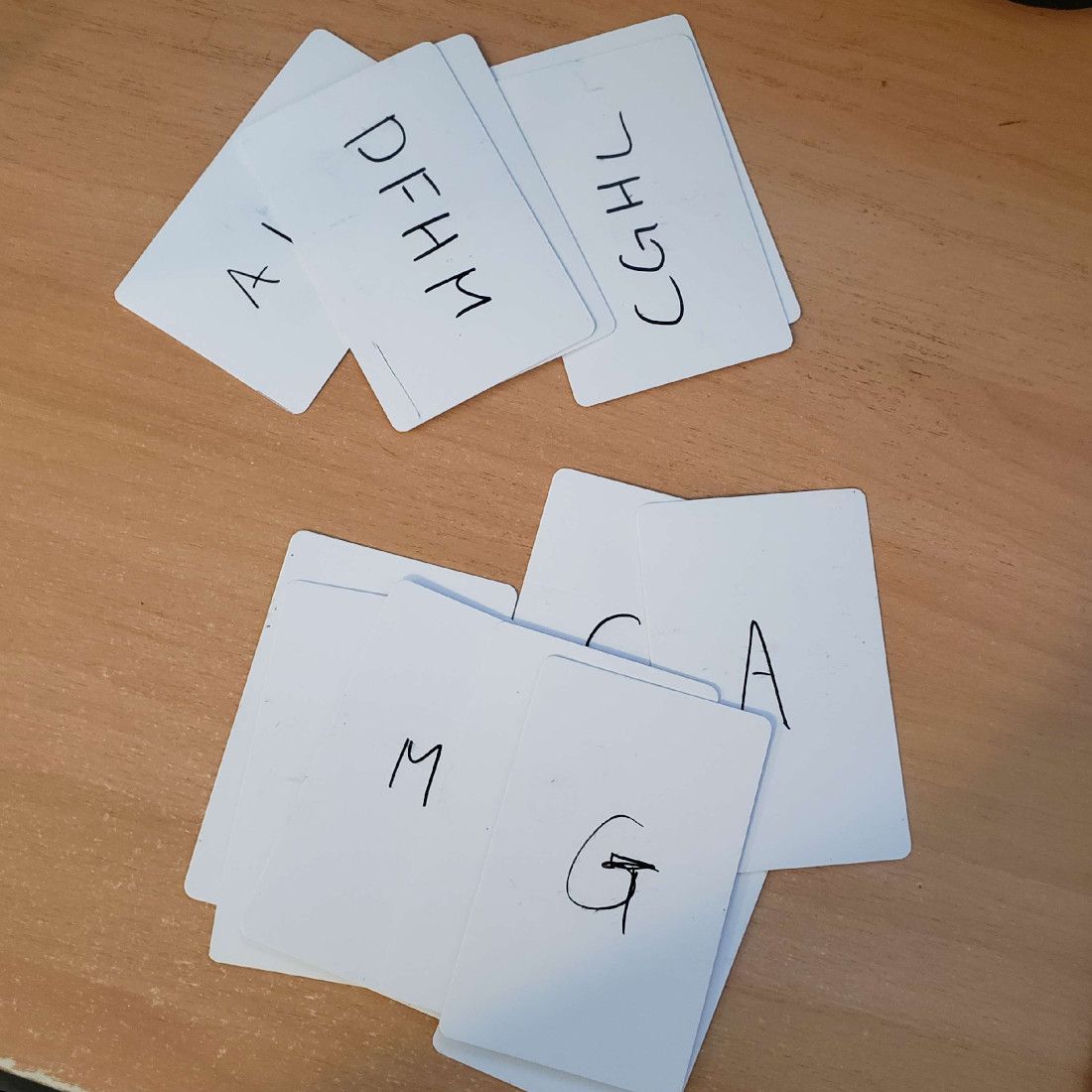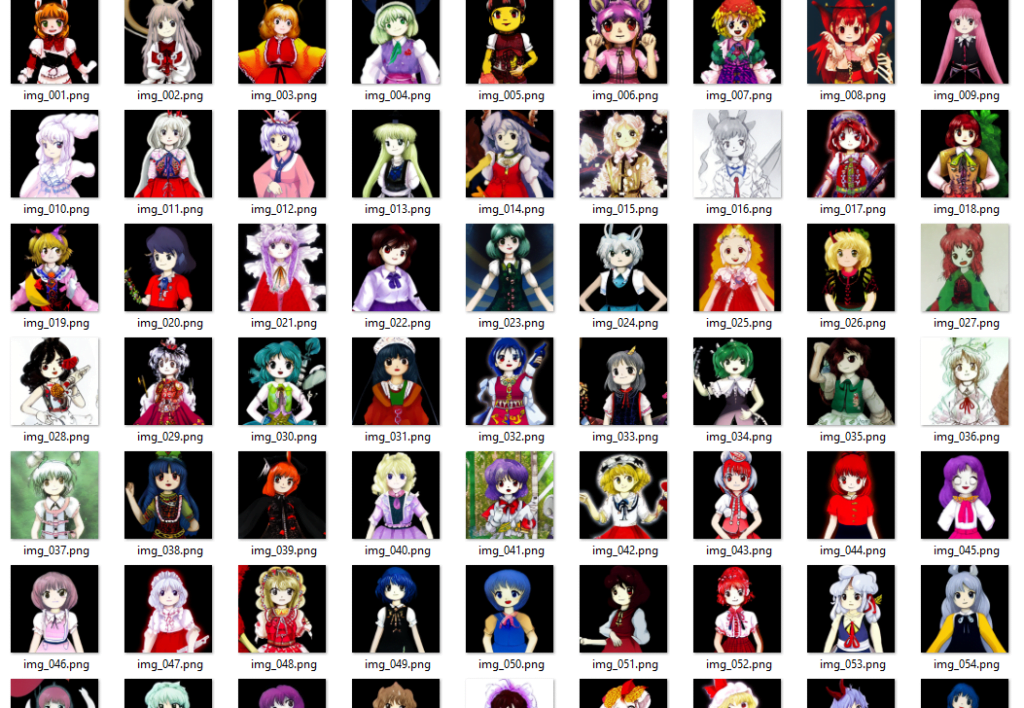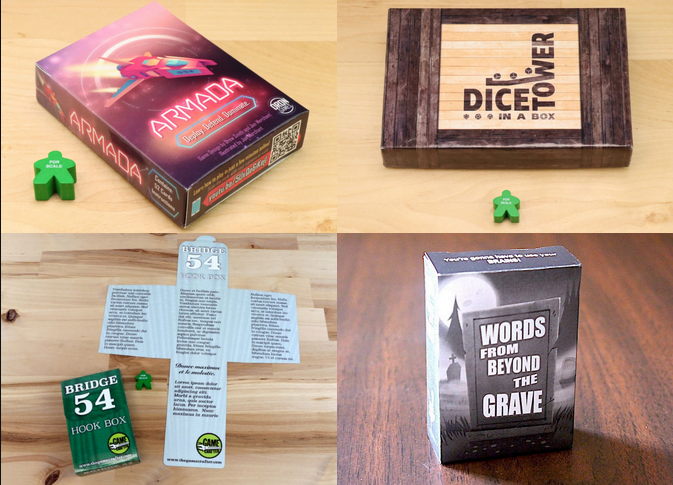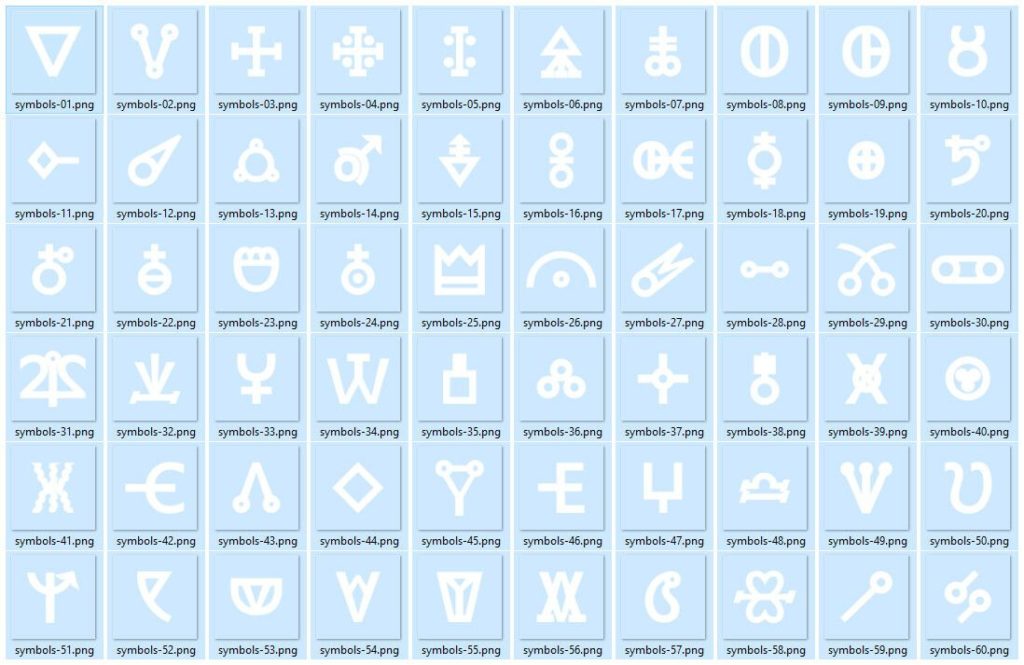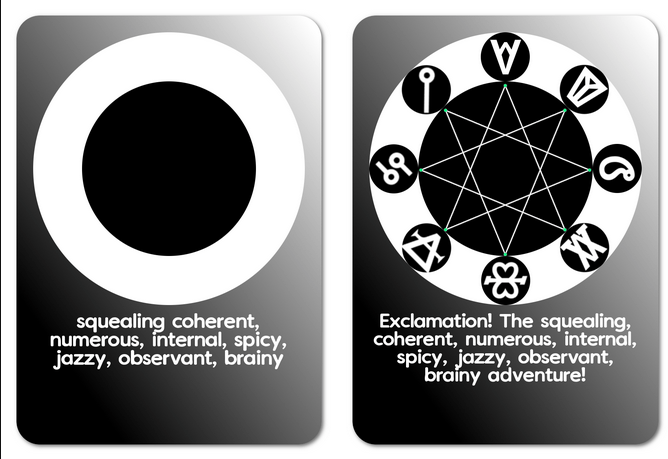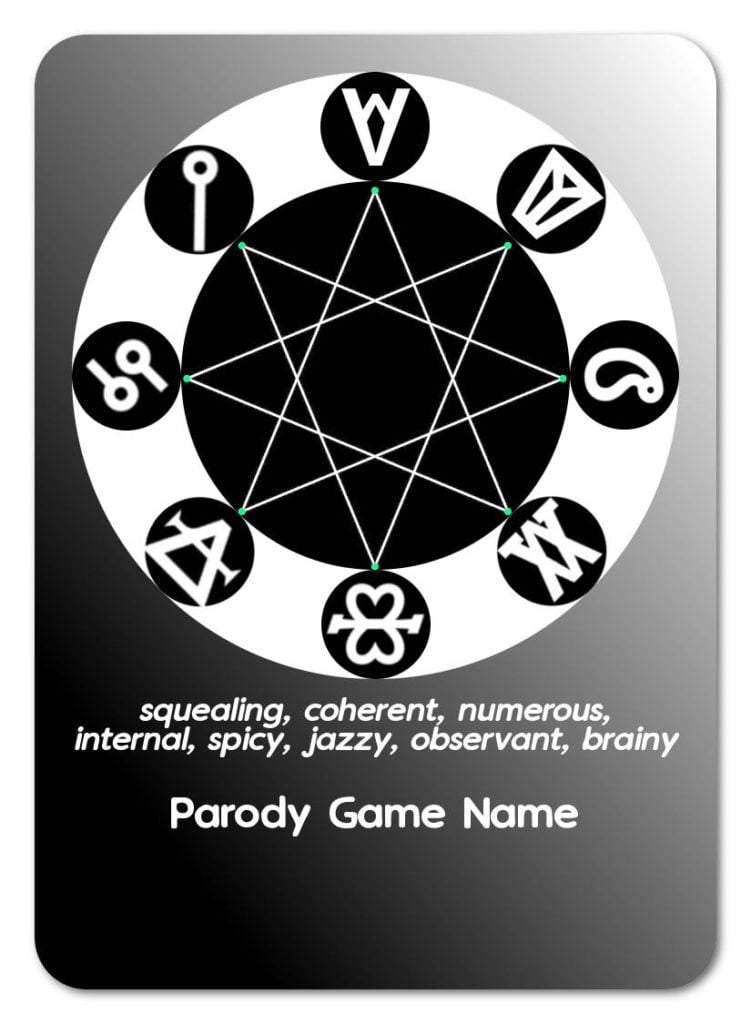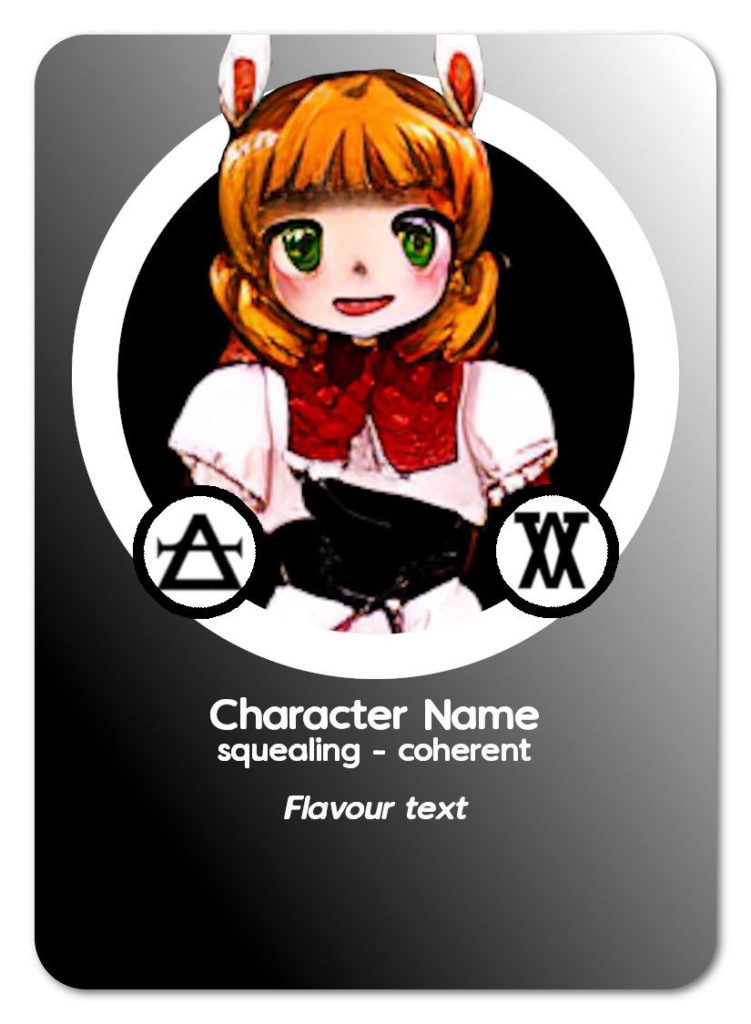Doing something different this time.
I am first up going to tell you what I wound up making and show you some examples of it. I’m going to explain where it’s at, and that’s all going to come before the fold. The full diary, which is a repost of material written over on my Cohost, is going to follow after. And we’re going to talk about sites like Cohost at some point in the next month or so, wew lord.
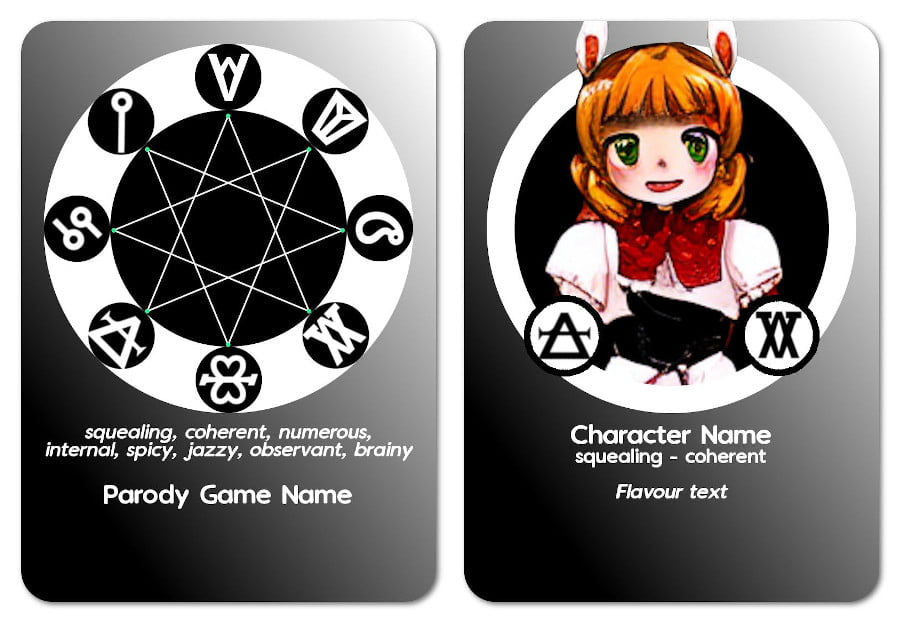
What I made this month is a prototype game design for a simple card game with a homogenous play form, focusing on hand management built on a classic mathematical puzzle you might see in the games Spot It and Dobble. The game has room to expand mechanically if it needs it, with each card having room for a rule or game mechanic to add to each character.
The game is composed of a deck of functionally similar cards; each card has a unique front and back. Each front face shows an alchemical summoning circle that describes a reading of a calamitous time, and a description of that in a set of keywords. The back face shows a magical girl from a mystical other realm (with art from the Touhou AI art bot) who represen two of those alchemical symbols and two of those key words.
The first turn of the game, you deal a number of these cards so their summoning circle faces are visible to the table, then deal each player a hand of magical girls, back-face-up. The deck is passed around from player to player, who get to do things to manage their hands, while they try and build a hand of cards that lets them ‘claim’ one of the quests as done.
That’s the game play experience, and cycle. I like that this needs no special components, and if it’s put in to a tuck box, it won’t need tons of setup. I also like that this prototype has room to develop: Each card could have a unique mechanical rule, a flavour or name joke, and the list of adjectives and alchemical symbols gives a lot of room for non-meaningful differentation.
Good idea, I like it, I did not get the time to order a prototype, but thanks to practice on Straight Outta Tucson, I have a tool available to me that can make turning this from ‘list of filenames’ to the actual cards very conveniently.
Dev diary follows!
Entry 1: Oops This Got Long
Okay so check out this thing:
What I’m curious about is when it comes to these dobble cards, for each card, is there something that card excludes? So let’s say you have a dobble deck, and you flip say, half the cards face-down. Is there some property you can assert about the face down cards that doesn’t apply to the face up cards?
So let’s ay the face up cards are currency, and let you buy face down card, but you need to spend (say) 3 cards; is it possible that there’s a meaningful difficulty with the face-down cards, or can literally any three-set of cards guarantee that?
Hmmm
Entry 2: Prototyping This
Okay, so after the post went up on my blog about it I kept working on this puzzle to come up with a useful card game I could make out of these parts. This is a version of the dobble deck that can be made with a set of 13 cards, 13 symbols, 4 symbols on each card.
Now, a bit of prototyping indicates that the simple puzzle of ‘can I construct one of these four-set cards with a hand of four cards’ is suitably interesting. Like, as a solo game, there is a learning phase where you have to go through the deck and understand what you definitely can’t do. If it was more complicated, and the game wasn’t directly under your control (ie, not solo any more), then it seems that the mechanic that drives the game just needs to be ‘what choices do you make about your turn.’
The next step is a theme and visual assets. Since part of this was working with AI assets, I’ve been thinking about ways to approach that in a way that create a potentially useful upgrade path. I think this game is going to have a lot of room for fiction if the system is this simple.
Entry 3: But What Art ASsets To Use?
AI Art assets are fraught to work with; the easiest way to do it is to buy packets after someone’s done the cultivation and post-processing for you. But what I wanted to discuss with this month’s project was the idea of art with an upgrade path, where the AI art could serve as a stand-in for the prototype stage of the game, but has a clear ‘upgrade path’..
Courtesy of @starwitch it was brought to my attention that there was a pre-existing corpus of interesting AI-generated art that had an upgrade path and wasn’t, you know, being trained on dubious sources. I grabbed the AI Touhou robot corpus.
So the idea now is that this game presents you with scenarios that require the involvement of Some Touhous, and all it takes is the invention of some ~50ish Touhou OCs that can be themed around two words.
Entry 4:
Okay so if every card has eight key signifiers on them, and two on the back, I’m going to want to make this information as processable as possible. To me that means if possible, multiple axes of access.
A good example of this is how, for example, a playing card gives you it’s number but also shows that many symbols on its face — it’s different ways to present redundant information in a way that’s easier for you to understand. A lot of colour blind accessibility has induced this as well — often a thing will have a colour AND a pattern.
Each card has functionally two pieces of game info on them: it’s type (a quest with a lot of needs, or a character who can meet two of them), and the needs on it (eight for a quest, two for a character). In simplest form these designs can just be those ABCD cards I showed.
What I think I want to do is to present that information in two different ways, and right now I’m thinking text and gems – little graphical shapes that can be told one from another…
… And now I need fifty seven keywords, and what’s more, fifty seven distinct symbols that don’t (for example,) become rotationally ambiguous (like any given triangle looks a lot like a lot of other triangles).
Entry 5: Mathematical Demands and Practical Demands
Okay, but here’s a new problem, and one that I think exists for Dobble as well.
mathematically, my design works and creates 57 cards. But if I make this game available for sale and distribution online, I’m going to want to use a vector like DriveThruCards or GameCrafter. And if I use those folks, I’m going to need this thing to fit in a standard set.
The nearest number to 57 on Gamecrafter’s standard boxes is 54. That right there is a problem because obviously, it means that there are three cards that need to be cut.
Today, what I did was grabbed a 72 card tuck box from DTC I already had, for Burning Daylight, and loaded it up with 57 cards. That’s 15 cards’ thickness in difference, which could be a space for a rulebook… but that’s a LOT of rulebook for a game that’s designed to be so simple.
I think this is a tolerable solution; I think given this game is meant to have a very homogenous play pattern (you shuffle the whole deck, deal some quests off it, then players play with cards they draw off the deck), having the whole thing in a tuck rather than a pro box feels like it could work… but a pro box would be nicer because it clearly communicates ‘this is not an ordinary deck of playing cards’ (a problem I’m dealing with a lot lately).
Entry 6: Pricing Art
One of the things that I want to do more of with this kind of prototyping is gather some meaningful, reasonable answers about potential costs, for documentation. So, for this project, I’m looking at around 57 cards, each of which has a little image of a Touhou on them as game assets.
So I thought I’d put it out there to ask, knowing that you don’t have to answer, and knowing that I’m not likely to follow up on it, if you’re an artist, what would you price this kind of work for a game project? Don’t worry about whether or not I can pay or you have the time, I just want part of this development process to include showing people what artists can expect to offer.
(Also if you see another artist offer a price you were scared to suggest, I recommend you probably aren’t charging enough and can afford to price your work higher)
Note: This did not get any responses or interest. This is probably due to the way Cohost handles tagged posts in a reply.
Entry 7: Developing Functionality on Cohost for Game Devving
If you tag a reply It won’t show up on that tag. This means that I can’t use subsequent posts in a reply thread like this to reach new people; replies are definitionally confined unless they invite you to share.
This is okay! I don’t want to change how Cohost Works (on that front at least; I’d love my stuff to be searchable). Now, if I want to put a post in a new thing, I should provide a link to the previous posts for context.
ALSO: This thread gets SUPER HUGE and unamangeable so I should be using ‘read more’ tags to compact it. And also not do things this way next time.
Entry 8: Symbolism!!!
you know what Touhou has a lot of in its various differnt weirdo UIs? Clocks! And Alchemy symbols!
At this point my idea for the card face is where these symbols each correspond to one of the descriptive terms.
next step: Put these in a frame, and then work on my list of adjectives and creating all 56 game titles that use these keywords.
Entry 9:
I feel like it could almost be more procedural generation if I have this list of keywords. I guess I should mock up a single card as an example.
Entry 10:
At first I imagined I might want to make these cards rotationally symmetrical – where the title text sat at the bottom and up at the top so players on either side of the card could read it. But I think that these symbols need
I might make the centre a clock face as WELL as an octagram, but I want to avoid giving people the wrong impression by including clock hands. That looks like game information and it absolutely isn’t important. Every card in this game is ‘equal’ in the current structure.
There’s redundant game info on this card. The keywords and symbols correspond, and are presented separately so if you find the symbols hard to parse, you can read the text, and vice versa.
Entry 11:
the really long chain-of-words names is interesting but they’re time consuming to tailor. What if instead, the keywords are just there as reminder text, mechanically, and the cards get a fun generic name instead.
Entry 12: Closing in on the end of the month
I have the template, the art, and the symbols, and the basic structure of the faces. Structure works, time to pour something into it to try and solve the prototype problem. So today, I sat down and made the list of game adjectives, which gives us the two defining characteristics of the 57 Touhous in this game. There’s a HUGE LIST down under the fold explaining a huge list of character names (from a random name generator).
More below the fold, of character name, then the two adjectives for the character:
- Miyazawa Koken (Musical, Dizzy)
- Henmi Satsu (Dizzy, Fearsome)
- Nakatomi Rin (Fearsome, Busy)
- Maeno Atsuko (Busy, Flirty)
- Akagawa Wakana (Flirty, Smug)
- Hayashida Kofuyu (Smug, Salty)
- Koki Eru (Salty, Gossipy)
- Ouchi Tooka (Disastrous, Jazzy)
- Date Sumiko (Jazzy, Scatterbrained)
- Seto Nanao (Scatterbrained, Picky)
- Mase Hide (Picky, Swag)
- Kitagawa Ari (Sleepy, Relaxed)
- Kibe Hainako (Relaxed, Giggly)
- Uramoto Reina (Giggly, Serious)
- Kaneshiro Tadako (Lively, Witchy)
- Wakaizumi Tamae (Witchy, Artistic)
- Mikami Sakiko (Charming, Fearless)
- Yutani Yui (Fearless, Ghosty)
- Takahata Dori (Ghosty, Chaotic)
- Konuma Rina (Dedicated, Poetic)
- Tachibana Mayo (Poetic, Mumbly)
- Matsuno Urara (Mumbly, Grumpy)
- Kamenashi Gemmei (Grumpy, Silly)
- Muratagi Miyu (Silly, Boastful)
- Wada Enri (Boastful, Shouty)
- Wakaki Kiko (Competitive, Nerdy)
- Haga Kazumi (Nerdy, Unhinged)
- Yukimura Hatomi (Unhinged, Belligerent)
- Kamata Aisa (Belligerent, Thoughtful)
- Tone Fuki (Thoughtful, Athletic)
- Nagano Kana (Athletic, Styling)
- Okuyama Iyo (Styling, Competitive)
- Nakauchi Wakana (Shouty, Fabulous)
- Kobayashi Dai (Fabulous, Brainy)
- Okuma Fukuko (Brainy, Offbeat)
- Mizusawa Hizuru (Offbeat, Huffy)
- Kugo Masu (Huffy, Charming)
- Kimura Ryoko (Swag, Gullible)
- Higa Yusa (Gullible, Sassy)
- Yumoto Akemi (Sassy, Lively)
- Arita Michizane (Chaotic, Sparkling)
- Yamaji Hiroyuki (Sparkling, Dedicated)
- Watabe Kenko (Serious, Chuuni)
- Komori Nobuyoki (Chuuni, Mysterious)
- Yoshihara Hoshiko (Mysterious, Cringe)
- Kaminaga Otsune (Cringe, Sleepy)
- Nishikawa Nanase (Artistic, Messy)
- Ota Yone (Messy, Playful)
- Kozutsami Wakuri (Playful, Driven)
- Yasuda Kino (Driven, Disastrous)
- Miyahira Kuni (Gossipy, Delicate)
- Ashikaga Akiko (Delicate, Forgetful)
- Kirishima Egao (Forgetful, Glorious)
- Shiroma Urano (Glorious, Flowery)
- Sada Kinuyo (Flowery, Gamer)
- Enatsu Mutsumi (Gamer, Weirdo)
- Ichinomiya Yumeji (Weirdo, Musical)
Entry 13: The Other Face
Other card face!
In case you’re pointing out ‘hey, this looks ugly,’ yeah. This is about setting up the card to ensure the information that needs to be communicated is all there. Think of it as blocking, or setting up the spreadsheet. The aim is to make sure that this can be all put into a CSV and then outputted clearly.
In this case, what this card face needs is:
- The character image
- The two alchemical symbols for her magic
- The name of the character
- The two keywords (which are text versions of the alchemical symbols)
- Room for flavour text
In the card file, this would be the odd-numbered faces, with the other face being the even-numbered; that makes this the obverse and the other face is the reverse. Technically, that makes this a ‘card back’ but also the card back looks like a front because they vary more.
The reverse has:
- The eight symbols for each card
- The text matching those eight symbols
- A flavour text entry explaining the ‘name’ of the card
The art I’m using is from the AI Touhou Twitter robot, as a it’ll-do stand in for examples. But I’m noticing that to get the vibe right for this, overwhelmingly, I’m going to need to do a lot of bespoke Touhou OC creation here, then get art of each one. That’s a lot of work I’m not good at! But the important thing at this point is the structure.
